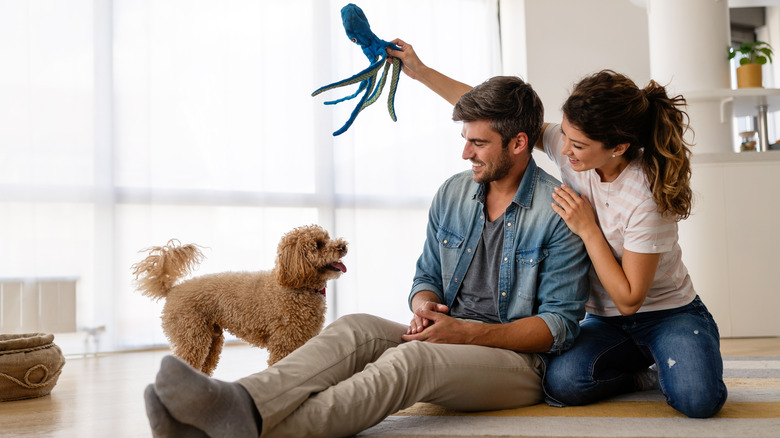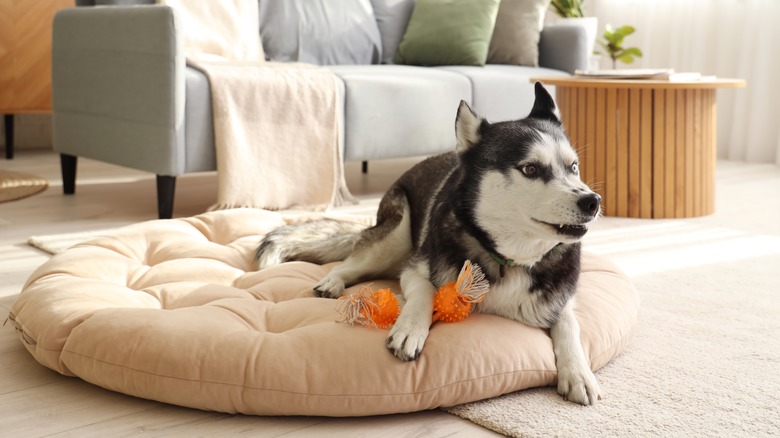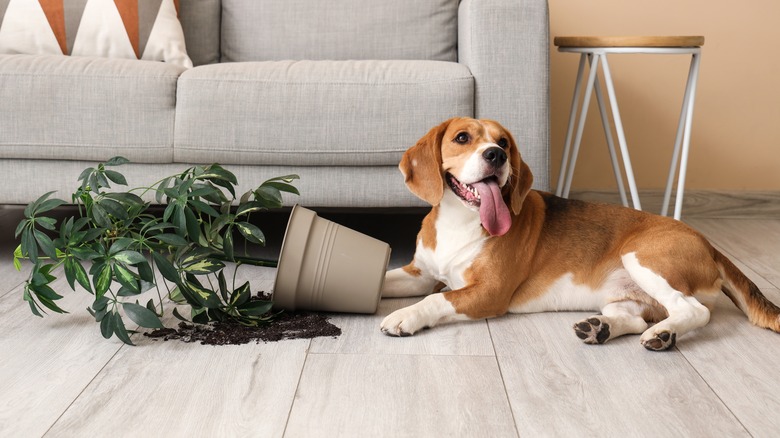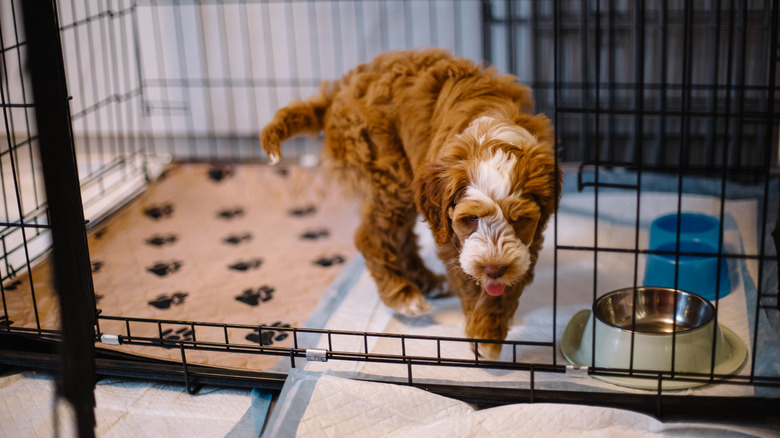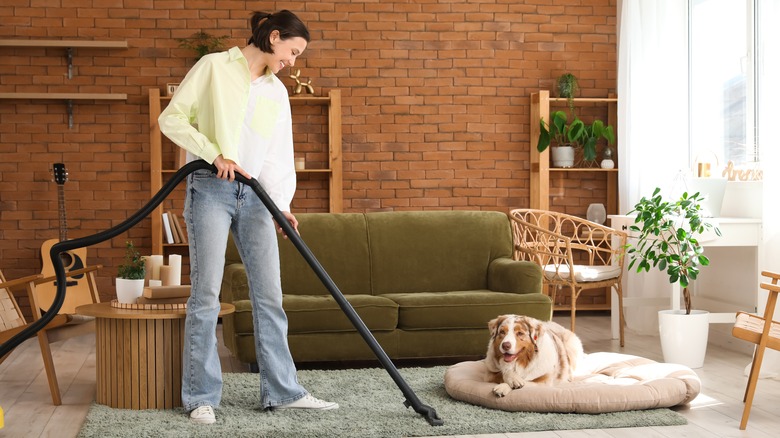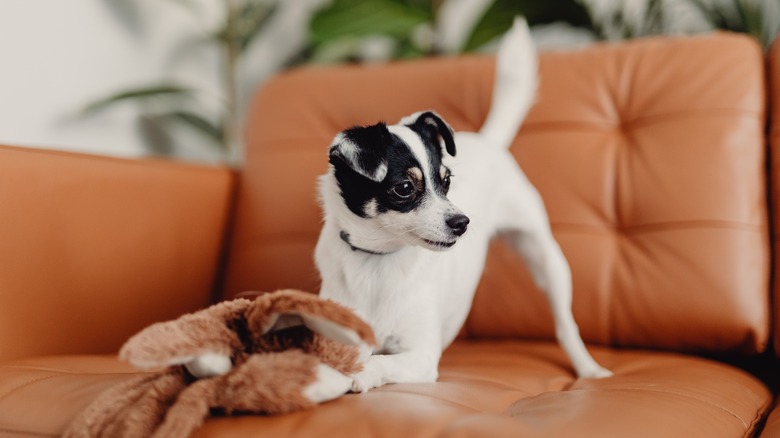Here's How To Prep Your Home Before You Get A Dog
We may receive a commission on purchases made from links.
Whether it's your very first dog or your first time introducing your current dog to a new residence, bringing a canine companion into a home is an exciting time. It's hard not to smile when you see them playing and exploring their surroundings, or when you realize they've adopted you as their new BFF. But to keep your pup –- and yourself -– content while you live under the same roof, you need to take time to make your dwelling inviting and safe. This means setting arrangements for when they'll be home alone and preparing for accidents.
They might be adorable, but dogs can do some not-so-adorable things like make messes on your carpet, chew your furniture, or leave scratch marks on the front door. If they're clumsy, they might also fall down a flight of stairs and hurt themselves. Additionally, dogs need stimulation in their environment in the form of toys and other objects, so it's important to be proactive and prepare for the possibilities — and the guarantees — when you decide to share your home with one. There are several things you should do during your first week with a new dog, but one of the most important is prepping your home before day one arrives.
Make your home welcoming to your dog
Dogs of all ages enjoy playing with toys, so buy a few and place them out in the open for your new companion to explore. It helps to have a variety, since not all dogs like the same ones. Squeaky toys, rope toys, and snuffle toys to engage your dog's foraging instincts can all be great options. Just make sure to buy size- and age-appropriate toys.
Another way to make your home inviting is by having treats on hand to reward them for good behavior. Of course, you'll also want to have a couple bowls out on the floor. If you want to welcome your pooch with a tasty meal and fresh water, fill the bowls prior to their arrival. If you prefer to place them on an eating and drinking schedule, wait until later to surprise them with their first meal in their new home.
At some point, your new companion will want to lie down to relax, so don't forget to bring home a comfy bed or two. Place the bed in a corner or against a wall that you can designate as their special space. If you decide to buy two, you might want to have one in the living room or other common area and the second one in your bedroom.
Eliminate or prevent access to potential canine dangers
Think of all the dangers that a dog in a new home could encounter without supervision: Your potted lilies, the chocolate chip cookies on your kitchen counter (if they're tall enough), the journey downstairs to retrieve a fallen toy. Even if your dog isn't a puppy, they'll still be curious about their new surroundings, so make sure to eliminate as many potential hazards as possible.
If you have potted plants in your home, make sure your dog can't access them, especially if any are poisonous. You should also familiarize yourself with toxic foods that dogs can't eat, and keep them out of their reach as well. Always close the pantry door and avoid leaving food out on the counter if your dog can reach it. Consider adding child locks, like Benny Bradley Baby Proofing Cabinet Locks to cupboard doors if your dog is smart and likely to break in. To prevent accidental tumbles down stairs, place a secure gate at the top of any steps, such as Cumbor 29.7" Pressure Mounted Pet Gate, in your home to block your pet's access.
Choking hazards are another potential danger to consider. Remember, dogs are curious by nature, and many like to chew on things they shouldn't, so make sure there aren't any small items lying around like batteries, hair ties, or random buttons, nails, or similarly-sized objects.
Buy a kennel, crate, or playpen
If your new pet isn't housebroken yet , you might find a crate beneficial to the training process. Along with helping to train their bladders, it teaches dogs to view roaming the house freely as a privilege. Moreover, it will minimize the chance of surprise accidents. Some breeds do well in playpens, so this could be another option for your pup. Keep in mind that the primary goal of a kennel, crate, or playpen is to keep your canine contained, which you may find necessary in the early days, even while you're home.
Don't forget to consider your dog's time outside as well. If you have a fenced-in yard with a secure gate and no potential escape routes underneath, your pup can be left to roam and play while you're home. If you don't have a fenced-in yard, however, you'll likely need to take them out on a leash, and if they've never been on one before, add "leash train your dog" to your to-do list. Want your pooch to have more freedom outside? Purchase an outdoor playpen or kennel, which come in various sizes and heights.
Worried about the cost of an enclosure? Don't be! You can find plenty of used dog kennels, crates, and playpens on sites like Facebook Marketplace, eBay, and OfferUp, sometimes for more than half off the "new" price. Some veterinary clinics and animal shelters also sell used kennels.
Stock up on pet-safe cleaning products
Most dogs inevitably make messes, and even the most well-trained of them can have an "oopsie" every once in a while. Sometimes pups urinate out of fear or excitement, or they might have diarrhea or vomit after eating a certain food. Regardless of the accident, you're probably going to have to clean up after your new pet at some point, so be prepared by buying the appropriate products.
If you have rugs or carpeting in your home, you'll want some type of carpet or fabric cleaner with stain and odor-removing properties. Many of these cleaners, such as Nature's Miracle Stain & Odor Remover, can also be used on furniture, curtains, hard floors, and other surfaces, so read the label before deciding which product to buy. You might also want to buy dog-friendly wipes, like Petinum Dog Cleaning Wipes for Allergies and Itching, to easily groom their paws and fur.
Another factor you'll have to consider in the cleaning department is shedding. While you probably already own a vacuum, consider purchasing one that's designed for sucking up pet hair. In addition to vacuums, you may want lint rollers for your clothes, as well as a squeegee, an unexpected tool that can effectively remove pet hair and dander from furniture and floors.
Protect your sofas (or buy new ones)
Fabric sofas offer warmth and comfort for humans, but they're usually not the best choice for households with dogs. Even if you don't plan to let your pet up on the couch, there's still a chance that they'll urinate on the parts closest to the floor. Although it's more common in males, any dog can mark their territory, including spayed females. Applying a stain and water repellent like Scotchgard to your couches and chairs can protect them from urine and other fluids that may stain.
If you're "Team Dogs on the Sofa," you may also want to purchase a large pet blanket or sofa-protecting cover, like gogobunny 100% Double-sided Pet Blanket, for your pup to lie on. Training your dog to sit only on a specific blanket can reduce the amount of hair and fur that you end up having to remove later from your furniture. It can also create a layer of waterproof protection should your canine have an accident.
While these can all be great ways to protect fabric couches from damage, stains, and odors, there's an alternative option you may want to choose: swapping your cloth furniture for quality leather seating. It's more expensive, but many dog owners consider the benefits worth the cost. Leather is typically less porous than cloth, making it easier to clean. It also doesn't absorb odors the way fabric does. And all that hair and fur? It won't stick to leather the way it would to cloth, which is another benefit that may sway your decision.
